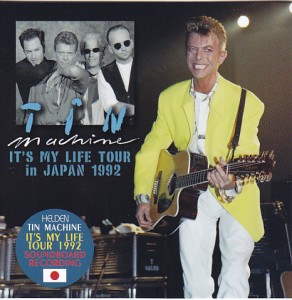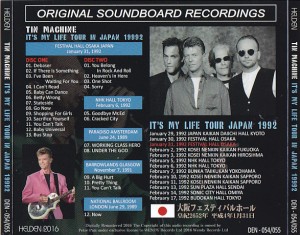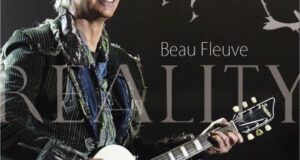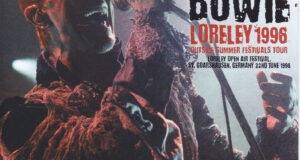Tin Machine / Its My Life Tour In Japan 1992 / 2CD / Helden
Translated Text:
Festival Hall Osaka Japan January 31, 1992. Soundboard
Click Image To Enlarge
Bowie in the 1980s and Will was the what. Bowie was one of the most famous cult hero is generally recognized, became the former Madonna and Michael Jackson side by side with the most famous artists was a Bowie in the 1980s. Enjoyed sales to unprecedented large success, also appeared in the movie, had earned a worldwide reputation is this time. Has been originally Bowie is to change the music to suit the times. I was riding on the disco boom of the 1980s in that sense may have been inevitable. Stylish and beautiful man of the blonde in a cosmopolitan atmosphere, while moving around the ornate stage in freely, lightly sing Dansanburu songs to back the band of the large number of people. And that man is David Bowie. What kind of songs of the genre even if Kakare to Bowie of hand turn into masterpieces as Midasutatchi. Is a feeling that it would be no reason not to hit.
However, on the other hand, fans of the old in too much of a change in Bowie from Berlin era is also certainly could not keep up. The course fan, it is but I do not have to accept if the selection of Bowie, one in which to prosperous to the world of Bowie had seemed like somewhere people’s affairs. Perhaps Bowie himself wonder the air felt. Do not the origin of the original of their music was rock, now obtained worldwide fame, or not there is need to go back to again origin, not is it inherently chose as his is a medium of expression Falcon. As if it were a reaction to the Serious Moonlight and Glass Spider, then chose the Bowie without getting the name of Bowie on the entire surface, it took the appearance that only participate as a member of the band, Tin machine was of the formation. 1988, the world was beginning to rush to the next era.
Enthusiasm of Bowie to be applied to the Tin Machine was as sure. Aligned members of the Tin Machine when it came to Japan in 1992, “Tamori music of the world” was guest appearance. I also I was looking at this program in real time at the time, but the question has been made to choose as a quiz to the performer the policy in the music of Tin Machine with a four 択. [1] I do not do the [2] do not use the computer [3] does not move around on the stage [4] 4 minutes or more of the songs that do not use the microphone. Come on, it would be none! Is a problem. Of course, the correct answer is not to use 2 of the computer, to be exact is the music of the band at the concept of the lock, the keyboard-less has been presented. Also in the program, it has also said that performing live was a spindle improvise like jazz. From the ornate decoration decorated with recoil of dance and pop music, of Bowie’s newly-oriented was a hard rock band of keyboard-less.
Tin Machine, but is the center is Bowie, two of the band members is a musician with a proven track record that was working the back of Iggy Pop, Reeves-Gaburerusu guitarist was a tour staff wife Bowie They are participating in the edge that was. Four bulls rock band of keyboard-less organization, this is the Tin Machine. First album “Tin Machine” to get the evaluation of published fixed in May 1989. But public interest is a because it is a band of Bowie, it was not a following even more, Tin Machine has become a remote cause that ended in the short term. In fact Bowie without getting myself on the whole surface, only the behavior as a member of the band, his solo songs on stage did not play at all. It helped also appeared to clutch the Katasukashi as a fan. I went to a concert of Tin Machine, there in spite of there are David Bowie, “Heroes” is also “Let’s Dance” is also not playing. Although the current Kenji Sawada is never to sing in “Breathless” is also “Casablanca Dandy” is also “TOKIO” stage, the divergence of the things I want to show what the artist side seeking fans become the most prominent It would be examples.
In 1990, Bowie has suspended the activities of the Tin Machine, past solo tour in the concept of singing their hit songs, extensively carry out the SOUND + VISION TOUR. Korezo because is what was asked of the fans, but would this time himself to understand, as advertised before that to seal the past of songs this tour at the end, after finishing the tour, Bowie Tin again It will be devoted to the machine of activities. The band’s second album, “Tin Machine II” will be announced in September 1991. SOUND + VISION Bowie refused to retreat in TOUR wonder was going to go full-scale to grow this band. For large-scale SOUND + VISION TOUR of performing a world tour with a huge stadium, Tin Machine had to expand the steady live activities in the center a small venue. With the benefit of hindsight, the same person to fill the tens of thousands of stadium, where you have to do in a few hundred scale of venue, not to feel that there is a limit of as a band. The second album in conjunction with the IT’S MY LIFE TOUR and entitled Tin Machine tour began, was that of October 1991, immediately after the release. Tour itself is intended to visit North America and Europe, was a scale that all 69 performances. But the venue is none small box is selected, the land of the tour last had in Japan. Dates are as follows in the Japan Tour.
January 29, 1992 Kyoto Kaikan
January 30, 1992 in Osaka Festival Hall
January 31, 1992 in Osaka Festival Hall
February 2, 1992 Kyushu Welfare Pension Hall
February 3, 1992 Mielparque Hall Hiroshima
1992 February 5, NHK Hall
February 6, 1992 NHK Hall
February 7, 1992 Kanagawa Prefectural
February 10, 1992 Hokkaido Welfare Pension Hall
February 11, 1992 Hokkaido Welfare Pension Hall
February 1992, 13 days Sendai Sun Plaza
Omiya Sonic City on February 14, 1992
February 17, 1992 NHK Hall
Those that go around without thoroughly the whole country over a long period of time, from Hokkaido to Kyushu, as you can see from the venue name, the man who in the fully occupied the Tokyo Dome two years ago, has performed live here even choose a small hall. This work than Japan tour of this Tin Machine 1992, has been recorded January 31, 2008 in Osaka. Tin Machine at this time did not have the material only song of two sheets album. Therefore or play a cover song on stage, or a different set list on a daily basis, any performance is also a dying tour is for the fans. Instead of the current packaged tour as, just band-concept as it is, what is the raw live unique fun can be of you do not know come out full of improvisation, it is of a live of Tin Machine.
This work is completely recorded in Osaka January 31, 1992 by the sound board. In the sound source members according to one estimate it is rumored to drained, as the great sound board sound source is the charm of hard rock that is powerful Tin Machine has become a thing where you can enjoy to the full extent. Feel listening to the live of Tin Machine, in the studio recording is the thickness of the felt no sense of speed and sound. Speed up the tempo in the live, in rolling up beat of rolling up playing guitar, wall of sound is attacked by a feeling like surging in front of the eyes. Powerful that this thickness despite kind there is no keyboard competence as a band would be how the great or certification. Again Tin Machine must listen in live. And do not the finished not be a short-lived if the more live performances at the penetration. Later in 1992 from the tour “oy vey, baby” when but live album that was announced already too late, and terms of content and a strong sense of digest also, was insufficient to convey its appeal. Come here, and I want you to re-recognize the appeal of Tin Machine in this work of the sound board full inclusion.
It should be noted that as a bonus track, are adding recorded rare songs that have not been played in this volume. First than the same 1992 tour to Japan from NHK Hall performances February 6 as “Goodbye Mr.Ed” two songs of “Cracked City”. Previously set list wrote and different every day, but the two songs are not played in Osaka. And June 24, 1989 from Amsterdam performances and “Working Class Hero” two songs “Under The God”. In songs of any of this two songs first album, especially the former is a cover of John Lennon. This butchery way is something that has become a hot topic at the time, but because heavier arrange and listen to live has been emphasized, I want you to try to listen by all means. It is further recording three songs than November 7, Glasgow concert 1991. And the last track is recorded a song called “Now” from the London show June 29, 1989. This song is not an exaggeration to say that the highlight of the bonus track. Although Bowie has said the title “Now”, this is what What is the original song of “OUTSIDE” of the 1995 announcement. The fact that was playing already in the stage as the Tin Machine six years ago indeed go back thing. Again Tin Machine It can be seen that there was an extension of the Bowie solo. Bowie is if carried out Tin Machine concept is a solo project as it is, also might evaluation also had changed.
Tin Machine It ended in commercial failure, and from the fact that drug addiction of drums hunt Sails had become to interfere with the band continued, naturally disappear after this Japan tour. But the sound that Bowie was this time-oriented, still no difference in that is the origin of Bowie, would not had been happy with the musical. After a solo tour is entrained the Reeves-Gaburerusu of guitar, there was no in Bowie until now, to reflect on the stage the sound like a hard rock, to replay the “Baby Universe” in solo tour such as, it has issued a tentative conclusion in the form of music that Bowie has been stalled while also oriented in Tin machine.
This work focused on David Bowie is keyboard-less and improvisation, of Tin Machine, which was formed by oriented hard rock, and complete recording of the concert in Japan in 1992 by the sound board. Improvisation such as jazz Bowie has asked the band, it does not come transmitted from the studio recording. Exactly is a feature that is exposed what in live is an unprocessed material, because there is also one of the important elements of the band concept, also Tin Machine is the real charm is not transmitted if Ne listen to live. Further in the bonus track recorded the rare songs that are not playing in the main, made to the structure can enjoy the live of Tin Machine with a single this title. Permanent preservation firmly press platen of the beautiful picture disc specification.
1980年代のボウイとは何だったのであろうか。最も有名なカルトヒーローだったボウイが一般的に認知され、かつてのマドンナやマイケルジャクソンと並んで最も有名なアーティストとなったのが1980年代のボウイであった。セールス的にかつてない大成功を収め、映画にも出演し、世界的な名声を得たのがこの時期である。元々ボウイは時代に合わせて音楽性を変遷させてきた。その意味では80年代のディスコ・ブームに乗ったことは必然であったかもしれない。スタイリッシュで都会的な雰囲気でブロンドの美しい男が、華美なステージを縦横無尽に動き回りながら、ダンサンブルな曲を大人数のバンドをバックに軽快に歌う。しかもその男はデヴィッド・ボウイである。どのようなジャンルの曲もボウイの手にかかればミダスタッチのように名曲に変わる。ヒットしないわけがないだろうという感じである。
しかし一方で、ベルリン時代からのボウイのあまりの変化に古くからのファンはついていけなかったのも確かである。もちろんファンとしては、それがボウイの選択であるならば受け入れなければいけないのだが、世間のボウイへの狂騒がどこか他人事のように思えていたものである。おそらくボウイ本人もその空気は感じていたのだろう。本来の自分の音楽の原点はロックであったのではないか、世界的名声を得た今、再び原点に戻る必要があるのではないか、それが本来自分が表現媒体として選んだものではなかったか。まるでシリアス・ムーンライトやグラス・スパイダーの反動であるかのように、次にボウイが選んだのはボウイの名前を全面に出さず、あくまでバンドの一員として参加するという体裁をとった、ティン・マシーンの結成であった。1988年、世界は次の時代に突入しつつあった。
ティン・マシーンにかけるボウイの意気込みは確かなものであった。1992年来日した際にティン・マシーンのメンバーが揃って「タモリの音楽は世界だ」にゲスト出演した。私もこの番組を当時リアルタイムで見ていたのだが、出演者へのクイズとしてティン・マシーンの音楽におけるポリシーを四択で選ぶ出題がなされた。【1】マイクを使わない 【2】コンピューターを使わない 【3】ステージ上を動き回らない 【4】4分以上の曲をやらない。さあ、どれでしょう!という問題である。 もちろん正解は2のコンピューターを使わない、正確にはキーボードレスのロック、というコンセプトでバンドの音楽性が提示されたのである。また番組内では、ジャズのような即興演奏を主軸としたライヴを行なっているとも語っている。華美な装飾を施されたダンス&ポップ・ミュージックの反動から、ボウイが新たに志向したのはキーボードレスのハードなロック・バンドであった。
ティン・マシーンはボウイが中心であるが、バンド・メンバーの内の二人はイギー・ポップのバックを勤めていた実績のあるミュージシャンであり、ギタリストのリーヴス・ガブレルスは妻がボウイのツアー・スタッフだったという縁で参加している。4人編成の硬派なキーボードレスのロック・バンド、これがティン・マシーンである。ファースト・アルバム『ティン・マシーン』は1989年5月に発表され一定の評価を得る。しかし世間の関心はそれがボウイのバンドであるからであって、それ以上でも以下でもなかったことが、ティン・マシーンが短期で終わった遠因となっている。事実ボウイは自分を全面に出さず、あくまでバンドの一員として振る舞い、ステージで自身のソロ曲は一切演奏しなかった。ファンとしては肩透かしをくらったと思われても仕方がない。ティン・マシーンのコンサートに赴き、そこにデヴィッド・ボウイがいるにも拘わらず、「ヒーローズ」も「レッツ・ダンス」も演奏しないのである。現在の沢田研二は「勝手にしやがれ」も「カサブランカ・ダンディ」も「TOKIO」ステージで歌うことはないが、ファンの求めているものとアーティスト側が見せたいものとの乖離が最も顕著になった例であろう。
1990年、ボウイはティン・マシーンの活動を休止し、過去の自分のヒット曲を歌うというコンセプトでソロ・ツアー、SOUND + VISION TOURを大々的に行なう。これぞファンの求めていたものであるというのが、この時本人も理解しただろうが、このツアーを最後に過去の曲は封印するという前宣伝通り、ツアーを終えた後、ボウイは再びティン・マシーンの活動に専念することになる。そして1991年9月にバンドのセカンド・アルバム『ティン・マシーンII』が発表になる。SOUND + VISION TOURで退路を断ったボウイは本格的にこのバンドを育てていくつもりであったのだろう。巨大なスタジアムでワールド・ツアーを行なうという大規模なSOUND + VISION TOURに対し、ティン・マシーンは小規模な会場を中心に地道なライヴ活動を展開していた。今となっては、数万人のスタジアムを埋め尽くす同じ人物が、数百人規模の会場でやらなければいけないところに、バンドとしての限界があった気がしてならない。セカンド・アルバムに伴いIT’S MY LIFE TOURと題されたティン・マシーンのツアーが始まったのは、リリース直後の1991年10月のことであった。ツアー自体は北米や欧州をまわるもので、全69公演という規模であった。しかし会場はどれも小さい箱が選ばれ、ツアー最終の地が日本であった。日本公演の日程は以下の通り。
1992年1月29日 京都会館
1992年1月30日 大阪フェスティバルホール
1992年1月31日 大阪フェスティバルホール
1992年2月2日 九州厚生年金会館
1992年2月3日 メルパルクホール広島
1992年2月5日 NHKホール
1992年2月6日 NHKホール
1992年2月7日 神奈川県民ホール
1992年2月10日 北海道厚生年金会館
1992年2月11日 北海道厚生年金会館
1992年2月13日 仙台サンプラザ
1992年2月14日 大宮ソニックシティ
1992年2月17日 NHKホール
長期に渡り全国を北海道から九州まで隈なく回るというもので、会場名を見てわかる通り、2年前に東京ドームを満席にした男が、ここでも小ホールを選んでライヴを行なっている。本作はこのティン・マシーン1992年の来日公演より、1月31日大阪公演を収録している。この時点でティン・マシーンはアルバム2枚分のマテリアルしか曲を持っていなかった。そのためステージではカバー曲を演奏したり、あるいは毎日のようにセットリストが異なり、ファンにとってはどの公演もたまらないツアーである。現在のようにパッケージ化されたツアーではなく、まさにバンド・コンセプトそのまま、即興性にあふれた何が出るかわからない生のライヴならではの楽しみが出来る、それがティン・マシーンのライヴなのである。
本作は、1992年1月31日大阪公演をサウンドボードで完全収録している。一説によるとメンバーが流出させたと噂される音源で、なるほど素晴らしいサウンドボード音源はティン・マシーンの迫力あるハード・ロックの魅力が存分に楽しめるものとなっている。ティン・マシーンのライヴを聴いて感じるのは、スタジオ録音では感じられないスピード感と音の厚みである。ライヴではテンポを速め、ギター弾きまくりの唸りまくりで、音の壁が眼前に押し寄せるような感覚に襲われる。キーボードの類がないにもかかわらずこの厚みある迫力はバンドとしての力量がいかに凄いかの証明であろう。やはりティン・マシーンはライヴで聴かねばならない。そしてもっとライヴでの演奏が浸透していれば短命でなくて済んだのではないか。後に1992年のツアーからは『oy vey, baby』というライヴ盤が発表されたが時は既に遅し、かつ内容的にもダイジェスト感が強く、その魅力を伝えるには不十分であった。是非ここは、サウンドボード完全収録の本作でティン・マシーンの魅力を再認識していただきたいと思っている。
なおボーナストラックとして、本編で演奏されなかったレア曲を追加収録している。まず同じ1992年来日公演より2月6日NHKホール公演から「Goodbye Mr.Ed」と「Cracked City」の2曲。先にセットリストが毎日異なったと書いたが、この2曲は大阪では演奏していない。そして1989年6月24日アムステルダム公演より「Working Class Hero」と「Under The God」の2曲。この2曲はいずれもファースト・アルバムの収録曲で、特に前者はジョン・レノンのカバーである。このぶち壊し方は当時話題になったものだが、ライヴで聴くとさらに重いアレンジが強調されているので、ぜひ聴いてみて欲しい。さらに1991年11月7日グラスゴウ公演より3曲収録している。そして最後のトラックは1989年6月29日ロンドン公演より「Now」という曲を収録している。この曲がボーナストラックの目玉といっても過言ではない。ボウイがタイトルを「Now」と語っているが、これが何と1995年発表の「OUTSIDE」の原曲なのである。実に遡ること6年前に既にティン・マシーンとしてステージで演奏していたという事実。やはりティン・マシーンはボウイのソロの延長にあったことがわかる。ボウイはティン・マシーンをコンセプトはそのままにソロのプロジェクトで行なっていれば、また評価も変わっていたのかもしれない。
ティン・マシーンは商業的に失敗に終わったこと、そしてドラムスのハント・セイルスの薬物中毒がバンド継続に支障をきたすまでになっていたことから、この日本公演の後に自然消滅する。しかしボウイがこの時期志向したサウンドは、依然としてボウイの原点であることに違いはなく、音楽的には満足していたのではないだろうか。後のソロ・ツアーではギターのリーヴス・ガブレルスを帯同させ、今までのボウイにはなかった、まるでハード・ロックのようなサウンドをステージに反映させ、「ベイビー・ユニバース」をソロ・ツアーで再演するなど、ボウイがティン・マシーンで志向しつつも頓挫した音楽の形に一応の結論を出している。
本作はデヴィッド・ボウイがキーボードレスと即興性を重視し、ハード・ロックを志向して結成したティン・マシーンの、1992年来日公演をサウンドボードで完全収録している。ボウイがバンドに求めたジャズのような即興性、それはスタジオ録音からは伝わってこない。まさにナマモノであるライヴでこそ表出される特長であり、バンド・コンセプトの重要な要素のひとつでもあるので、やはりティン・マシーンはライヴを聴かねば本当の魅力は伝わらない。さらにボーナストラックでは本編で演奏していないレアな曲を収録し、このタイトル1枚でティン・マシーンのライヴを堪能できる構成になっている。美しいピクチャー・ディスク仕様の永久保存がっちりプレス盤。
FESTIVAL HALL OSAKA JAPAN January 31, 1992
DISC ONE
01. Debaser
02. If There Is Something
03. I’ve Been Waiting For You
04. I Can’t Read
05. Baby Can Dance
06. Betty Wrong
07. Stateside
08. Go Now
09. Shopping For Girls
10. Sacrifice Yourself
11. You Can’t Talk
12. Baby Universal
13. Bus Stop
DISC TWO
01. You Belong In Rock And Roll
02. Heaven’s In Here
03. One Shot
04. Sorry
NHK HALL TOKYO February 6, 1992
05. Goodbye Mr.Ed
06. Cracked City
PARADISO AMSTERDAM June 24, 1989
07. WORKING CLASS HERO
08. UNDER THE GOD
BARROWLANDS GLASGOW November 7, 1991
09. A Big Hurt
10. Pretty Thing
11. You Can’t Talk
NATIONAL BALLROOM LONDON June 29, 1989
12. Now
Helden. Den 054/055
 GiGinJapan Artwork of Japanese CDs (mostly)
GiGinJapan Artwork of Japanese CDs (mostly) 



